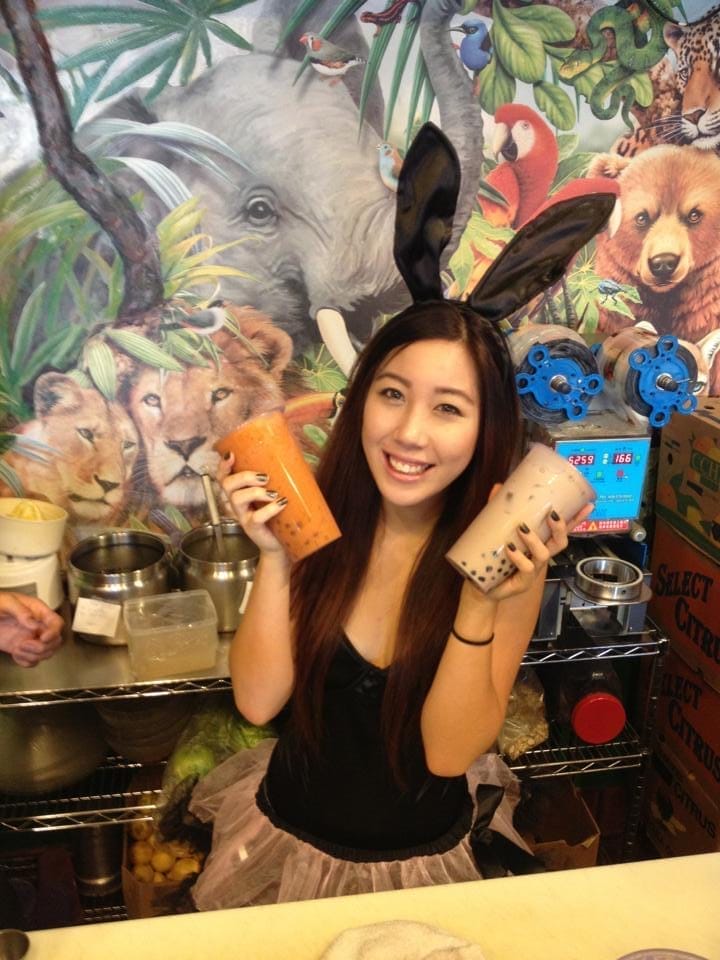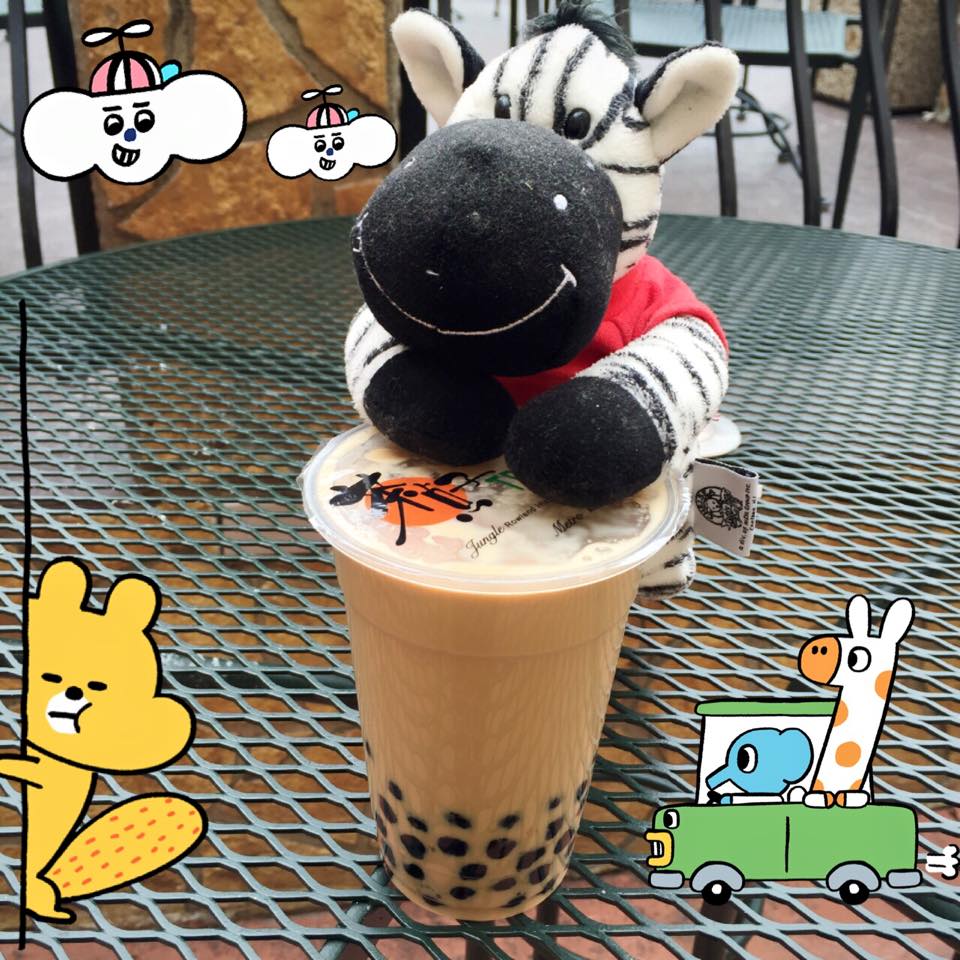Boba tea origins are as intriguing as the drink itself.
Also known as bubble tea, this beverage has become a global sensation, but its journey from a Taiwanese tea shop to a beloved treat worldwide is both fascinating and personal.
If you’ve ever enjoyed a drink filled with chewy tapioca pearls, you might be curious about the story behind this unique beverage.
Let’s explore its origins, how it reached the U.S., and its development into a cultural phenomenon.

Save and Share boba history
A Taste of Taichung: The Birth of Boba Tea
Our story begins in Taichung, Taiwan, in the 1980s.
My older brother was one of the pioneers, opening one of the first bubble tea shops in the area.
The innovation involved adding chewy tapioca pearls to sweetened milk tea.
This was a departure from traditional Taiwanese desserts, which used tapioca balls but never in a drink format.
In Taiwan, the pearls used in milk tea were initially smaller.
The drink is commonly known as “pearl tea” (珍珠奶茶, zhēnzhū nǎichá), where “pearls” refers to the tapioca pearls.
However, the U.S. version introduced larger pearls, leading to the playful term boba (波霸, pronounced bō bà), which informally translates to “big boobs” in Mandarin.

At the time, bubble tea was a novel concept.
When it made its way to the U.S., it brought not just a new flavor but also new technology.
Sealing plastic cups on-site with pointy fat straws to poke through became a hallmark of the boba tea experience.
The technology was so intriguing that people were amazed by how drinks are sealed right in front of them!

Crossing Oceans: Bubble Tea Arrives in the U.S.
Boba tea began to make its mark in the U.S. in the 1990s, first appearing in areas with significant Asian communities.
Quickly and Lollicup were among the first Taiwanese chains to introduce bubble tea to American shores.
They brought not only the drink but also the technology of sealing cups and using pointy straws, which added to the unique experience.
Initially, prices for bubble tea were quite affordable, starting at $2.50 for a small cup and occasionally even as low as $0.99.
Although Quickly and Lollicup have become less common, they still operate in some locations.
Individual shops that focused on higher-quality drinks have thrived, and the tradition of bubble tea continues to grow.
The introduction of bubble tea to the U.S. saw it quickly capture the interest of college students and young adults, who were drawn to its unique texture and customizable flavors.
Bubble tea shops often set up near colleges and universities to cater to this enthusiastic demographic.

From Niche to Mainstream: Boba’s Evolution
Today, boba tea is more than just a drink; it’s a cultural icon.
The variety of options available is vast, from classic milk teas and fruity blends to coffee-infused drinks and fruit smoothies.
Boba shops also offer a range of treats beyond bubble tea, including shaved ice, hot dessert soups, and traditional Taiwanese street food like popcorn chicken.

Fun Fact: The American version of popcorn chicken is inspired by a popular Taiwanese street food! Originally known in Taiwan for its crispy, bite-sized chicken pieces, this tasty treat has been adapted into a fast-food favorite in the U.S
Do you like Taiwanese popcorn chicken? If so, you may want to try this Chinese eggplant recipe and recreate the delicious Taiwanese flavor!

Boba has become so popular, American corporations have joined the boba trend as well.
Major brands like Starbucks and Dunkin’ Donuts have introduced seasonal or test menu boba drinks featuring popping boba.
Del Monte has also released a boba-flavored drink, JOYBA Bubble Tea.

These pre-made products highlight the popularity of boba tea in the U.S., though they use popping boba rather than traditional chewy pearls.
This choice is likely due to the challenges of preserving the chewy texture in pre-made products, which requires frequent preparation.
Additionally, many Americans may find popping boba more approachable than traditional chewy pearls.
If you’re interested in trying these seasonal boba drinks, make sure to visit before they are taken off the menu.
Who knows? As popular as boba drinks are, they might become permanent fixtures in the future.
If you want to make your own traditional boba at home, there are many DIY kits on the market now. Give it a try!

As an Amazon Associate, I earn a small commission from qualifying purchases at no additional cost to you.
The Addictive Appeal of Boba Tea
Boba tea is one of those unique beverages where the first sip often leads to a strong reaction—people either love it or hate it.
Its distinctive combination of chewy tapioca pearls and sweet, flavorful tea can be polarizing.
However, for those who fall in love with it, such as me, the addiction is real.
The chewy texture of the tapioca pearls and the variety of flavors create an irresistible experience that keeps fans coming back for more.
In Taiwan, drinking multiple a day is the norm!

What Are Boba Pearls Made Of?
Boba pearls, also known as tapioca pearls, are primarily made from tapioca starch, which is derived from the cassava root.
This starch is mixed with water and sometimes other ingredients to create a dough-like consistency.
The dough is then shaped into small balls and cooked until they achieve a chewy texture.
The process involves boiling the pearls in water until they become translucent and soft.
After cooking, the pearls are often soaked in a sweet syrup to enhance their flavor and to keep them from sticking together.
This chewy, slightly sweet texture is a key characteristic of traditional boba pearls and is what gives the drink its distinctive experience.
Traditional Chewy Boba vs. Popping Boba
Traditional Chewy Boba:
- Texture: Traditional boba pearls are chewy and have a gelatinous consistency. They are made from tapioca starch, which gives them their distinctive texture.
- Preparation: These pearls need to be cooked regularly to maintain their chewy texture. They are typically boiled until they reach the desired consistency and are often soaked in a sweet syrup to enhance flavor.
- Usage: Traditional boba is used in a wide variety of drinks, including milk teas and fruit teas, and is a staple in many bubble tea shops. It adds a satisfying texture to the drink that many boba enthusiasts cherish.
Popping Boba:
- Texture: Popping boba is different from traditional boba pearls. It has a thin, gel-like outer layer that bursts with juice when bitten into, creating a burst of flavor.
- Preparation: Popping boba is made using a process called spherification, where a liquid flavor is encapsulated in a thin gel membrane. Unlike traditional boba, it does not require cooking.
- Usage: Popping boba is often used in drinks and desserts as a fun and flavorful addition. It has gained popularity in places like Starbucks and Dunkin’ Donuts for its novelty and ease of integration into pre-made products.
In Summary:
- Traditional boba offers a chewy, substantial texture that enhances the experience of drinking bubble tea. It needs to be freshly prepared and is best enjoyed immediately to retain its texture.
- Popping boba, on the other hand, provides a burst of flavor and is easier to incorporate into ready-made drinks. It has become popular in commercial settings where maintaining the chewy texture of traditional boba is challenging.
Interestingly, both types of boba are vegan-friendly, making them suitable for various dietary preferences.
The chewy texture of traditional boba and the burst of flavor from popping boba cater to different tastes, but both can be enjoyed without concern for animal products.
Artisan Touch: Why Local Boba Shops Matter

Artisan boba shops play a crucial role in delivering high-quality bubble tea.
Maintaining the perfect chewy texture of traditional boba requires regular cooking and careful attention—something that’s challenging for large corporations to manage consistently.
Artisan shops cook their boba multiple times a day to ensure it remains fresh and chewy, providing a level of quality that mass-produced options often lack.
Keeping Your Boba Fresh
If you plan to enjoy your boba tea later, it’s best to avoid adding ice to the drink and, if possible, keep the boba separate from the tea.
Boba that soaks in cold liquid for over an hour can lose its chewy texture and become jelly-like.
For the best experience, enjoy your boba tea immediately after purchasing.
Sitting around for more than an hour at room temperature also diminishes the texture, so it’s best consumed fresh.
A Personal Connection: My Boba Journey
Boba tea holds a special place in my heart and my life.
My older brother was one of the first to open a bubble tea shop in Taichung in the 1980s, and I fondly remember spending summer vacations in Taiwan enjoying the pearl tea.
I proudly carried on the tradition by opening my own bubble tea shop in Rowland Heights, California in my late 20’s.
Rowland Heights, California was one of the first places in the U.S. to offer boba.
Shipping ingredients, cups, straws, and sealing machines directly from Taiwan was a significant undertaking, as there were no suppliers in the U.S. at the time.

Running the shop for nine plus years was an exhilarating and unforgettable chapter of my life.
If you have any questions about boba drinks, I’m happy to share my insights and experiences!
Final Thoughts
From its origins in a Taichung tea shop to its place in global food culture, boba tea’s journey showcases its unique blend of tradition and innovation.
The next time you enjoy a cup of bubble tea, take a moment to appreciate its rich history and the way it has become a part of our lives.
What’s your favorite boba flavor or memory? Share your stories about this delightful drink that continues to capture hearts and taste buds around the world. Are you addicted?


Leave a Reply